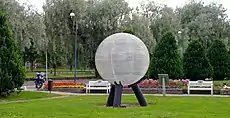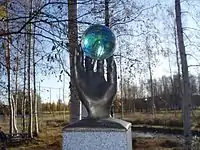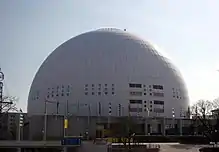Sweden Solar System
The Sweden Solar System is the world's largest permanent scale model of the Solar System. The Sun is represented by the Ericsson Globe in Stockholm, the largest hemispherical building in the world. The inner planets can also be found in Stockholm but the outer planets are situated northward in other cities along the Baltic Sea. The system was started by Nils Brenning and Gösta Gahm[1] and is on the scale of 1:20 million.[2]

Sun, Mercury, Venus
Jupiter
The system

The bodies represented in this model include the Sun, the planets (and some of their moons), dwarf planets and many types of small bodies (comets, asteroids, trans-Neptunians, etc.), as well as some abstract concepts (like the Termination Shock zone). Because of the existence of many small bodies in the real Solar System, the model can always be further increased.
The Sun is represented by the Ericsson Globe (Globen), Stockholm, which is the largest hemispherical building in the world, 110 m in diameter. To respect the scale, the globe represents the Sun including its corona.
Inner planets
- Mercury (25 cm in diameter) is placed at Stockholm City Museum, 2,900 m from the Globe. The small metallic sphere was built by the artist Peter Varhelyi.
- Venus (62 cm in diameter) is placed at Vetenskapens Hus at KTH (Royal Institute of Technology), 5,500 m from the Globe. The previous model, made by the United States artist Daniel Oberti, was inaugurated on 8 June 2004, during a Venus transit and placed at KTH. It fell and shattered around 11 June 2011. Due to construction work at the location of the previous model of Venus it was removed and as of October 2012 cannot be seen. The current model now at Vetenskapens Hus was previously located at the Observatory Museum in Stockholm (now closed).
- Earth (65 cm in diameter) is located at the Swedish Museum of Natural History (Cosmonova), 7,600 m from the Globe. Satellite images of the Earth are exhibited beside the Globe. An elaborate model of the Moon (18 cm in diameter) is on display in another part of the museum.
- Mars (35 cm in diameter) is located at Mörby Centrum, a shopping centre in Danderyd, a suburb of Stockholm. It is 11.6 km from the Globe. The model, made in copper by the Finnish artist Heikki Haapanen, is connected by an "umbilical cord" to a steel plate on the floor having an Earth image.[3] The globe also features marks that represent some typical Martian chemical elements.
Gas giants
- Jupiter (7.3 m in diameter) is placed at the roundabout near Sky City, in Stockholm Arlanda Airport in Sigtuna Municipality, 40 km from the Globe. It is made as a flower decoration, with different flowers representing different zones of the giant gas planet. There are plans to build a 3D model.
- Saturn (6.1 m in diameter) is placed outside the old observatory of Anders Celsius, in the so-called Celsius Square, in the centre of Uppsala, 73 km from the Globe. Inaugurated during the International Year of Astronomy,[4] the model is a mat with a picture of Saturn, but will eventually grow to crown a school planetarium in the city. In addition, several schools in Uppsala are to provide moons of Saturn: the first completed was Enceladus (diameter 2.5 cm) at Kvarngärdesskolan.[5]
- Uranus (2.6 m in diameter) was vandalized and the new model was reconstructed behind Stora magasinet in Lövstabruk in 2012. It is an outdoor model made of blue steel bars. The rotation axis of the planet is marked in red.[6]
- Neptune (2.5 m in diameter) is located by the river Söderhamnsån in Söderhamn, a coast town with tradition of fishing and sailing (which relates to Neptune being the deity of the seas). Placed 229 km from the Globe, the model is made of acrylic and, at night, shines with a blue light.
Trans-Neptunian objects

- Pluto (12 cm in diameter) and its largest moon Charon are placed near the southern of the Dellen lakes, in Delsbo, 300 km from the Globe. The lakes are thought to be formed by a meteorite impact 90 million years ago. The two bodies' sculptures are supported by two gravelike pillars (as Pluto is the deity for death), made up with dellenite, a rare mineral formed at that place by the meteorite impact.
- Ixion (6.5 cm in diameter), a dwarf planet candidate, is located at Technichus, a science center in Härnösand, 360 km from the Globe. The sculpture is an orb held by a hand with the arm. This plutino was discovered by a team which included scientists from Uppsala.
- Eris (13 cm in diameter) is located at Umestans Företagspark, Umeå, 510 km from the Globe. Made by Theresa Berg, the golden model is inspired by the mythical story of Eris sparking a quarrel between three Greek goddesses with a golden apple bearing the inscription καλλίστῃ ("to the most beautiful one").
- Sedna (10 cm in diameter), another dwarf planet candidate, is located at Teknikens Hus, a science center in Luleå, 912 km from the Globe.
Other bodies

- The near-Earth Object Eros is located at Mörbyskolan, a school in Danderyd Municipality (where Mars is located), 11 km from the Globe. It was created as a Valentine's Day project in gold, modeled after Eros, the god of love. The dimensions are 2 × 0.7 × 0.7 mm (0.98 mm³).
- The asteroid 36614 Saltis is located at Saltsjöbaden's Kunskapsskola, a school near the Stockholm Observatory. The asteroid was discovered by A. Brandeker in 2000, using a telescope at the observatory, and the body was named after the observatory's location, Saltsjöbaden.
- The asteroid Vesta is located at Åva gymnasium, a public secondary school in Täby.
- The asteroid Palomar-Leiden (0.2 mm in diameter) is located in a park in Alsike, Knivsta Municipality, 60 km from the Globe. It is not a sculpture but a dot on a map of the System, placed in front of Erik Ståhl's monumental cosmic sculptures.
- Halley's Comet is located at Balthazar Science Center, in Skövde. Inaugurated on 16 December 2009, there are actually four models of the comet: three placed outdoors, based on schoolchildren's drawings, plus one indoors, consisting of a laser passing through a block of glass.
- Comet Swift-Tuttle is placed at Kreativum, a science center in Karlshamn. The comet's orbit is closest to the Globe in inner Stockholm and farthest in Karlshamn, 390 km away.
- The Termination Shock is at the edge of the heliosphere: it is the boundary where the solar wind transitions to subsonic velocity. No sculpture currently represents the termination shock, but a foundation for a future sculpture exists at the Institute of Space Physics, 950 km from the Globe, in Kiruna, above the Arctic Circle.
List of objects
| Object | Distance from Globen[7] | Diameter[7] | Location[7] | Coordinates | Inauguration date |
|---|---|---|---|---|---|
| Sun | 0 km | 71 m (233 ft), the disk 110 m (361 ft), incl. the corona | The Ericsson Globe in Stockholm | 59°17′36.80″N 18°04′59.65″E | - |
| Mercury | 2.9 km (1.8 mi) | 25 cm (9.8 in) | Stockholm City Museum in Stockholm | 59°19′11″N 18°04′16″E | 1998 |
| Venus | 5.5 km (3.4 mi) | 62 cm (24.4 in) | Vetenskapens Hus | 59°21′10.38″N 18°03′30.78″E | 8 June 2004 |
| Earth and Moon | 7.6 km (4.7 mi) | 65 cm (25.6 in) and 18 cm (7.1 in) | Cosmonova Riksmuseet in Stockholm | 59°22′08.48″N 18°03′12.34″E | before 2000[8] |
| (433) Eros | 11 km (6.8 mi) | 2.0 mm × 0.7 mm × 0.7 mm | Mörbyskolan, a school in Danderyd | 59°23′38″N 18°02′41″E | |
| (36614) Saltis | 11 km (6.8 mi) | < 1 mm | Kunskapsskolan, a school in Saltsjöbaden | 59°16′21″N 18°18′17″E | 14 January 2010[9] |
| Mars | 11.6 km (7.2 mi) | 35 cm (13.8 in) | Mörby Centrum in Danderyd | 59°23′52.58″N 18°02′11.58″E | before 2000[8] |
| 4 Vesta | 16.4 km (10.2 mi) | 2.6 cm | Åva gymnasium in Täby | 59°26′24″N 18°03′47.16″E | 6 September 2017[10] |
| Jupiter | 40 km (25 mi) | 7.3 m (24 ft) | Arlanda airport in Märsta | 59°38′58.52″N 17°55′50.38″E | before 2000[8] |
| (5025) Palomar-Leiden | 60 km (37 mi) | 0.2 mm | in Alsike | 59°45′25″N 17°45′57″E | |
| Saturn | 73 km (45 mi) | 6.1 m (20 ft) | Celsius square in Uppsala | 59°51′34″N 17°38′14″E | 13 June 2009[4] |
| Uranus | 125 km (77 mi) | 2.6 m (8.5 ft) | Stora magasinet in Lövstabruk | 60°24′31″N 17°52′37″E | 13 October 2012[11] |
| 1P/Halley comet | 204 km (127 mi) | Balthazar Science Center in Skövde | 58°23′14″N 13°51′11″E | 16 December 2009[12] | |
| Neptune | 229 km (142 mi) | 2.5 m (8.2 ft) | by the river Söderhamnsån in Söderhamn | 61°18′07″N 17°03′19″E | 29 October 1998[13] |
| Pluto and Charon | 300 km (186 mi) | 12 cm (4.7 in) and 6 cm (2.4 in) | by the lake Dellen South, in Delsbo | 61°47′50.13″N 16°32′59.96″E | before 2000[8] |
| (28978) Ixion | 360 km (224 mi) | 6.5 cm (2.6 in) | Technichus, a science center in Härnösand | 62°37′49″N 17°56′12″E | 18 April 2002[14] |
| 109P/Swift-Tuttle comet | 390 km (242 mi) | Kreativum, a science center in Karlshamn | 56°11′39″N 14°51′09″E | ||
| (136199) Eris | 510 km (317 mi) | 13 cm (5.1 in) | Företagspark in Umeå | 63°50′05″N 20°15′37″E | 6 December 2007[15] |
| (90377) Sedna | 810 km (503 mi) | 10 cm (3.9 in) | Teknikens Hus, a science center in Luleå | 65°36′59.50″N 22°08′06.00″E | 8 December 2005[16] |
| Termination shock | 950 km (590 mi) | A plate | Institute of Space Physics in Kiruna | 67°50′27″N 20°24′34.5″E |
Gallery
 The Ericsson Globe represents the Sun. The rest of the Solar System is scattered in, and north of, Stockholm.
The Ericsson Globe represents the Sun. The rest of the Solar System is scattered in, and north of, Stockholm. Mercury in Stockholm
Mercury in Stockholm Venus in Stockholm
Venus in Stockholm Earth in Stockholm
Earth in Stockholm Mars in Stockholm
Mars in Stockholm Neptune in Söderhamn
Neptune in Söderhamn Asteroid Vesta in Täby
Asteroid Vesta in Täby Sedna in Luleå
Sedna in Luleå The foundation for the sculpture of the Termination Shock in front of the Swedish Institute of Space Physics in Kiruna.
The foundation for the sculpture of the Termination Shock in front of the Swedish Institute of Space Physics in Kiruna.
See also
- Somerset Space Walk
- Nine Views
- St Kilda Solar System Trail
References
- "Sweden Solar System: Bakgrund" (in Swedish). Sweden Solar System. Retrieved 2009-09-15.
- "Sweden Solar System: English summary". Sweden Solar System. Retrieved 2009-09-15.
- Danderyds Kommun: Mars
- Press release, linked 2009-06-08.
- List of moons of Saturn assigned to schools in Uppsala (in Swedish).
- http://www.arbetarbladet.se/uppland/tierp/uranus-landade-i-lovsta
- "Sweden Solar System: Stationer" (in Swedish). Sweden Solar System. Retrieved 15 September 2009.
- "Tours of Model Solar Systems". Psych.illinois.edu. Retrieved 4 October 2013.
- Ny Teknik: Saltis invigs i Saltis Archived 23 June 2010 at the Wayback Machine
- http://www2.taby.se/ava
- http://www.unt.se/uppland/tierp/uranus-invigdes-i-lovstabruk-1904483.aspx
- "Sweden Solar System: Halleys komet". Ttt.astro.su.se. 16 December 2009. Retrieved 4 October 2013.
- Neptunus i Söderhamn
- "Technichus' Exhibitions". Technichus home Page. Archived from the original on 14 August 2010. Retrieved 10 May 2010.
- Umeå kommun: Umeå får en egen himlakropp Archived 29 September 2011 at the Wayback Machine
- "Luleå är Sedna. I alla fall om vår sol motsvaras av Globen i Stockholm". Norrbotten Kuriren (in swedish). Archived from the original on 15 July 2010. Retrieved 10 May 2010.
External links
| Wikimedia Commons has media related to Sweden Solar System. |